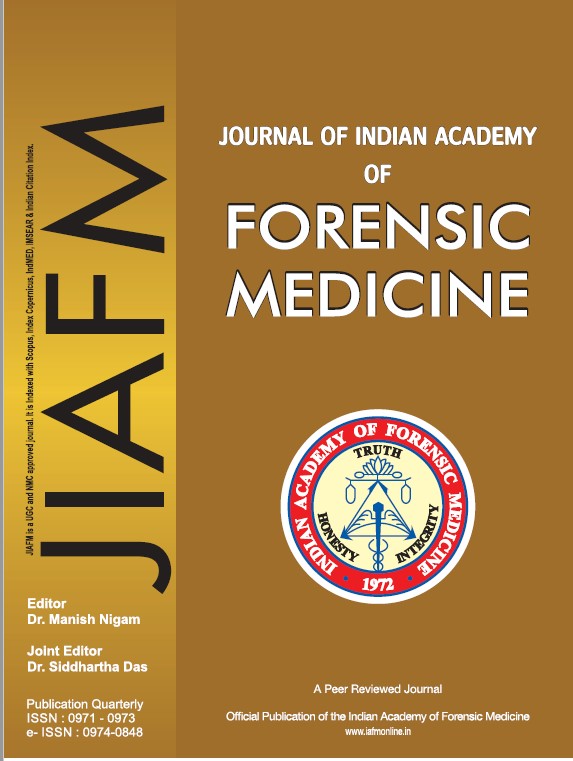Morphology of Lip Prints in Ethnic Meitei Subjects : A Preliminary Analysis of Patterns and Sexual Variation
DOI:
https://doi.org/10.48165/jiafm.2023.45.4.2Keywords:
Identification, Lip prints, Cheiloscopy, Sexual dimorphismAbstract
Lip prints are individualistic and can be helpful in verifying a person's presence at the crime scene. This cross sectional study aims to classify lip prints in ethnic Meitei population and determine whether sex differences exist. Estimated sample size is 250. Lip prints of 137 females and 113 males were obtained using dark-colored lipstick and cellophane tape. Lip prints were analyzed using a magnifying lens and classified according to the Suzuki and Tsuchihashi classification. The upper and lower lips of males and upper lips of females revealed Type II to be the predominant pattern, accounting for 19%, 13.8% and 22% of all occurrences, respectively. In females, a Type I pattern was the most frequent in the lower lips (22%). These differences were statically significant (p < 0.001). A correlation analysis, with Spearman's rank order correlation (rho), was used. The strength of the linear relationship between the lip patterns for the upper and lower lips (right and left sides) and sex was analyzed. We found a medium correlation value (from 0.030 to 0.412) with statistical significance (p < 0.005) for upper right lip and lower left lip with the exception of the upper left lip (correlation value = 0.092 , p = 0.147 & ) and lower right lip (correlation value = 0.030, p = 0.642). This study corroborates the hypothesis that lip prints may be useful in sex determination.
Downloads
References
Reddy KSN, Murty OP. The Essentials of Forensic Medicine th and Toxicology. 34 edition. New Delhi : The Health sciences Publisher; 2017. p.53.
Matsuno H, Kanoh T, Tadokoro O, Inoue K. Preliminary study of post mortem identification using lip prints. Forensic Sci Int. 2005;149:129-32.
Suzuki K, Tsuchihashi Y. A new attempt of personal identification by means of lip print. J Indian Dent Assoc. 1970; 42: 8-9.
Augustine J, Barpande SR, Tupkari JV. Cheiloscopy as an adjunct to forensic identification: a study of 600 individuals. J Forensic Odontostomatol.2008; 27(2):44-52.
Sheikh NA, Londhe PS. Cheiloscopy: A Tool for Solving Crime and Identification. Indian Journal of Forensic Medicine and Toxicology. July-Dec., 2012; 6(2): 133 -135.
Vahanwala S, Nayak CD, Pagare SS. Study of lip-prints as aid for sex determination. Med Leg Update. 2005;5:93–8.
Gondivkar SM, Indurkar A, Degwekar S, Bhowate R. Cheiloscopy for sex determination. J Forensic Dent Sci. 2009;1:56–60.
Patel S, IshPaul S, Madhusudan AS, Gayathri R, Sowmya GV. A study of lip prints in relation to gender, family and blood group. Int J Oral Maxillofac Pathol.2010;1(1):4–7.
Ponce AC, Segu M, MuÇoz MCN, Verdffl Pascal FA.
Revelado de huellas labiales invisibles con reactivos fluorescentes. Cuadernos Med Leg For. 2003;34:43–7.
Webb LG, Egan SE, Turbett GR. Recovery of DNA for forensic analysis from lip cosmetics. J Forensic Sci. 2001;46(6):1474–9.
Ball J. The current status of lip prints and their use for identification. J Forensic Odontostomatol. 2002;20(2):43–6.
Segu MA, Feucht MM, Ponce AC, Pascual F. Persistent lipsticks and their lip prints: new hidden evidence at the crime scene. Forensic Sci Int.2000;112:41–7.
CastellA, Alvarez M, Verdffl F. Just lip prints? No: there could be something else. FASEB J. 2004;18(6):615–6.
Augustine J, Barpande SR, Tupkari JV. Cheiloscopy as an adjunct to forensic identification: a study of 600 individuals. J Forensic Odontostomatol. 2008;27:44–52.
Lévêque JL, Goubanova E. Influence of age on the lips and perioral skin. Dermatology. 2004; 208:307-13.
Prabhu RV, Dinkar A, Prabhu V. Digital method for lip print analysis: A New approach. J Forensic Dent Sci. 2013; 5(2): 96–105.
Durbakula K, Kulkarni S, Prabhu V, Jose M, Prabhu RV. Study and comparison of lip print patterns among Indian and Malaysian dental students. J Cranio Max Dis. 2015; 4:5-11.
Sivapathasundharam B, Prakash PA, Sivakumar G. Lip prints (cheiloscopy), Indian J Dent Res. 2001;12:234-37.
Koneru A, Surekha R, Nellithady GS, Vanishree M, Ramesh D, Patil RS. Comparison of lip prints in two different populations of India: Reflections based on a prelimnary examination.J Forensic Dent Sci. 2013;5:11-5.
Kapoor N, Badiye A. A study of distribution, sex differences and stability of lip print patterns in an Indian population. Saudi J Biol Sci. 2015;112–131.
Ragab AR, El-Dakroory SA, Rahman RH. Characteristic patterns of lip prints in Egyptian population sample at Dakahlia Governorate. Int J Legal Med. 2013;127:521–527.


